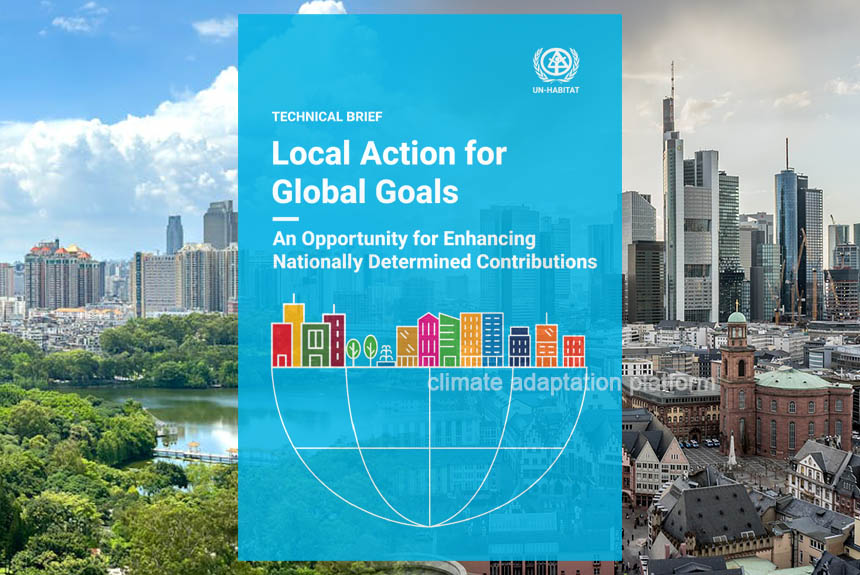Cities are culprits, victims, and potentially saviours of the climate crisis. This is according to the report published by UN-Habitat, UNDP, and the UNESCO Chair on Urban Resilience at the University of Southern Denmark (SDU.Resilience), which analysed the climate commitments of 194 countries party to the 2015 Paris Climate Agreement.
The technical brief released on 5 June 2025 highlights the significant role of cities in helping their countries achieve their climate goals through their Nationally Determined Contributions (NDCs).
More than half of the world’s population lives in cities, which is projected to grow to 68% by 2050. Rapid urbanisation, economic, and population growth contribute to a surge of GHG emissions in urban areas. As of 2020, cities account for around 70% of global emissions, up from 62% in 2015 and around three-quarters of energy consumption. Urban emissions could double by mid-century without mitigation efforts, exacerbating climate change impacts, according to the IPCC 2022 report.
While cities are vulnerable to climate change impacts, around 70% of urban cities worldwide already feel the effects of climate change. They are also recognised as critical agents in implementing climate solutions.
The brief examines the Nationally Determined Contributions (NDCs) of 194 countries ratifying the Paris Agreement.
A technical brief from UN-HABITAT, Local Action for Global Goals, highlights cities’ untapped potential to help their countries achieve their climate goals. The report, released on 5 June 2024, examines the Nationally Determined Contributions (NDCs) of 194 countries that have ratified the Paris Agreement.
NDCs are individual country-level commitments that outline the efforts and actions a country intends to take to reduce its greenhouse gas (GHG) emissions and adapt to the impacts of climate change. Countries or parties are required to update their NDCs every five years, and with each round of submissions, they are expected to strengthen their climate ambitions. Initial NDCs were submitted in 2015 and updated in 2021. Now, parties are again preparing to submit their updated NDCs in 2025 just ahead of COP30 or the 30th session of the Conference of the Parties in November 2025 in Brazil.
Analysis of the latest round of NDCs submitted in June 2023 revealed that 129 (66%) of the 194 NDCs contain either moderate or strong levels of urban content.
The latest NDCs were examined using 200 indicators and then categorised into three broad clusters based on the level of urban elements or content: strong, moderate, and low or no urban content.
- ‘Strong’ urban content means that NDCS has specific urban sections or considers urban a priority sector.
- ‘Moderate’ urban content includes NDCs featuring urban mentions within the text that are not within a dedicated urban section.
- ‘Low or no’ urban content includes NDCs with a low level or no explicit urban references in the text.
Of the 194 NDCs, 39% have moderate urban content, 34% have low or no urban content, and only 27% include strong urban elements.
The report points out that strengthening the urban content of the NDCs is vital for raising their overall ambition and for effectively implementing climate adaptation and mitigation policies.
Local climate action can contribute to national climate goals and strengthen climate adaptation and resilience, yet this potential remains underutilised. It offers an opportunity to highlight cities’ roles in upcoming NDCs.
The report features two initiatives launched during the two separate COP events—the Coalition for High Ambition Multilevel Partnerships (CHAMP) launched during COP28 and the SURGe (Sustainable Urban Resilience for the Next Generation Initiative) introduced at COP27.
CHAMP aims “to spur greater collaboration between national and subnational governments in climate action planning.”
It aims “to unlock and realise mitigation and adaptation action opportunities at the subnational level by involving cities, towns, states, and regions in the planning, financing, and implementing NDC climate strategies by 2025.”
Over 70 countries, including the EU, endorsed CHAMP.
SURGe, on the other hand, “provides an additional platform to translate national commitments into localised, cross-sectoral climate action.”
The brief states, “There is a golden opportunity to strengthen the nexus between climate change and urbanisation and enhance the urban content in the NDCs.”
Source:
Local Action for Global Goals. An Opportunity for Enhancing Nationally Determined Contributions. Technical Brief. (2024). UN-HABITAT. Retrieved from https://unhabitat.org/sites/default/files/2024/02/un-habitat_ndcanalysis-technicalbrief.pdf
Igini, M. (2024, June 5). Potential of Cities in Tackling Climate Change Still Largely Untapped, UN Says. Earth.Org. Retrieved from https://earth.org/potential-of-cities-in-tackling-climate-change-still-largely-untapped-un-says/



Leave a Reply